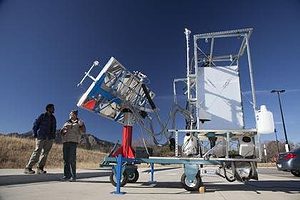One of the 16 teams involved in a collaborative project funded by the Bill & Melinda Gates Foundation that aims to help some of the 2.5 billion people around the world lacking safe and sustainable sanitation recently unveiled their innovative design: a solar-powered toilet that treats solid waste by effectively carbonizing it. The concentrated solar power delivers high energy in the waste chamber, sterilizing it and transforming it into biochar – a highly porous charcoal used to both increase crop yields and sequester carbon dioxide.
Karl Linden, professor of environmental engineering at University of Colorado Boulder, and colleagues developed a next-generation toilet destined for poor and unaccessible areas where waste disposal isn’t effectively disposed of in a centralized manner.

The high tech latrine consists of eight parabolic mirrors that focus concentrated sunlight to a spot no larger than a postage stamp on a quartz-glass rod connected to eight bundles of fiber-optic cables, each consisting of thousands of intertwined, fused fibers, said Linden. The energy generated by the sun and transferred to the fiber-optic cable system — similar in some ways to a data transmission line — can heat up the reaction chamber to over 600 degrees Fahrenheit to treat the waste material, disinfect pathogens in both feces and urine, and produce char.
Char is a very useful material because of its high water retaining properties. A soil mixture containing 10 percent biochar can hold up to 50 percent more water and increase the availability of plant nutrients, thus helping improve crop yields. Additionally the charcol has carbon mitigating properties, helping reduce greenhouse gases released into the atmosphere. Alternatively, you can release the trapped carbon back into the atmosphere by burning it to extract energy comparable to that of commercial charcoal.
“We are doing something that has never been done before,” said Linden. “While the idea of concentrating solar energy is not new, transmitting it flexibly to a customizable location via fiber-optic cables is the really unique aspect of this project.”
Tests have shown that each of the eight fiber-optic cables can produce between 80 and 90 watts of energy, meaning the whole system can deliver up to 700 watts of energy into the reaction chamber, said Linden. In its current form, the toilet was designed to meet the needs of six people a day, however larger facility that could serve several households simultaneously are currently being considered. The key here is cost, especially considering the toilet’s target group. The researchers claim a cost level of five cents a day per user can be reached.
The team of researchers involved in the project will travel to Delhi, where their invention along with 15 other produced by researchers from other University will be on display March 22. Other institutional winners of the Gates Foundation’s “Reinvent the Toilet Challenge” range from Caltech to Delft University of Technology in the Netherlands and the National University of Singapore.
“We have a lot of excitement and energy on our team, and the Gates Foundation values that,” Linden said. “It is one thing to do research, another to screw on nuts and bolts and make something that can make a difference. To me, that’s the fun part, and the project is a nice fit for CU-Boulder because we have a high interest in developing countries and expertise in all of the renewable energy technologies as well as sanitation.”


